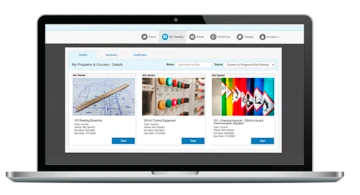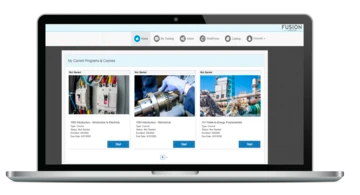If you’re experiencing budget cuts or belt-tightening at work, maximizing your training budget may not feel intuitive. However, it is an impactful step to take in securing your maintenance team’s skills and reducing the risk of expensive accidents and citations. In this article, you’ll read our top 10 tips for maximizing your training budget and keeping your technicians’ skills fresh and up-to-the-minute, so unplanned downtime doesn’t jeopardize your commitments to your customers or your team’s safety.
1. Start with gap assessments
Identify skill weaknesses early so you don’t waste time or money training in areas workers have already mastered.
Use pre- and post-tests; Results point to the subjects each individual needs to learn based on their specific aptitudes.
Request a Training Needs Evaluation for a more comprehensive look at how to build a training program specific to your team’s knowledge gaps.
2. Prioritize high-impact skills
Focus first on training that improves safety for dangerous tasks, reduces unplanned downtime, or addresses common failure points at your facility.
Start with your citation history. Provide corrective action training to prevent repeat incidents and prepare your team to complete root cause analysis.
Encompass skills that reduce the chances of other top-cited hazards (see the most recent list here)
Make a list of those machines that absolutely cannot be down during production. Prioritize skills used to maintain those most critical machines
Focus on those skills that help your maintenance team plan downtime for when production teams are not at work or not using those machines.
3. Use a blended learning approach
Combine online and simulation-based training to accommodate different learning styles.
Reach the newest generations of industrial maintenance workers with learning tools more familiar to these digital natives, such as simulated, computer-based practical learning
Provide an immersive environment for quick skill acquisition and practice finding root cause analysis, without risks to your people or machines.
Flexibly train your team whenever they are waiting for tickets to come in; they’ll have the opportunity to start and stop as often as needed.
4. Train for cross-functionality
Upskill technicians to handle multiple systems or tasks, increasing workforce flexibility and coverage.
Instead of siloing your experts, use eLearning and simulators to help your team gain new skills and be able to flex to different areas and cover time off, time away due to injury, or help out as you’re backfilling open roles.
Follow an established learning path to bring your team from no knowledge to competency in new areas.
Choose an online course or simulation module to learn the skills needed for a specific repair instead of going in blind.
5. Reduce onboarding time
A pre-approved training plan helps new hires reach productivity faster, reducing wasted spare parts, speeding up repairs, and acquainting them with the terminology you use to keep everyone on the same page.
Ramp up best practice knowledge fast when your program is ready-to-go before a new hire’s first day.
Onboarding is not just about paperwork and learning your specific machines – it is also about introducing new hires to the way that you talk about repairs, best practices, and training culture.
6. Use scalable digital tools
Invest in training platforms that grow with your workforce, avoiding constant reinvestment and complicated scheduling.
Lean into tools that are flexible-first, such as simulated repairs. A training simulation gives your techs the chance to try out repairs in a safe environment instead of winging them on your expensive equipment.
Look for systems leveraging progressive faults to scale maintenance abilities – from entry-level to advanced troubleshooting.
7. Look for the most flexible tools
Find opportunities for unlimited-per-seat training for always available learning – or opt for access to a number of course credits usable by any team member. Subscription-based training models offer the greatest flexibility in total cost, ease of use, and how to navigate training.
Use a subscription-based model with unlimited access so your team can train any time they aren’t working on repairs. Choose from a per-seat option, course credits that anyone on your team can use, or buy as your team needs to learn.
Look for simulation-based training that grows with your team, from fundamental tasks to complex troubleshooting – with flexible subscription options for teams or individuals.
Identify training that allows your techs to start & stop any time, so your team isn’t tied to a training location and doesn’t have to delay repairs or maintenance to finish up training.
8. Leverage third-party programs
Lean on training that is built on regulatory standards and expertise in training and maintenance to ensure consistent quality and eliminate the cost of building internal programs from scratch.
Need continuing education units (CEUs)? Look for a provider that can offer IACET accredited courses and the CEUs to prove your team is sharp.
Not all habits embrace safety first. Cut out the potential for passing along lazy or dangerous habits by adding training created for teams like yours.
Seek training that is built by experts with a variety of strengths: learning and educational technology whizzes, experienced maintenance technicians and instructors, and experts in regulatory and compliance requirements.
9. Do a quick knowledge check
Not sure if your team learned enough during training? Use pre- and post-tests or on-the-job-training checks to find out how much know-how they gained.
These tools double up as a quick way to check the return on a training investment.
10. Track ROI with KPIs
Measure performance improvements (e.g., repair time, parts waste, downtime reduction) to justify and guide future spending and find out what the return is on your training investment.
Simulations may have cost calculators built in so managers can find out exactly how much time and spare parts your team is saving – or wasting – before it impacts your backstock and downtime. Calculating how these costs improve over time helps managers understand current skill levels and where maintenance team members have improved, is a simple way to see a production-oriented return.
Use common calculations, like mean time between failures (MTBF), to find out how consistent your team is, and compare before and after training.
Track spare parts use over time to understand when team members are replacing a bad part on repeat and when they’ve replaced the root cause instead.
Calculate the change in unplanned downtime before and after training or use a downtime calculator to find out how much it costs before and after your maintenance team completes their training.
When it comes to budget-friendly training, TPC has you covered. Our online technical skills courses run the gamut – covering all the critical repair and troubleshooting skills in accessible, flexible, easy-to-navigate online training. TPC Simulations help your team learn with progressive faults – ultimately helping your technicians follow a systematic process to find underlying causes of failures instead of just replacing the resulting bad parts. With core topics and skills in electrical, HVAC, mechanical, and everything in between, our solutions just make sense for busy maintenance professionals.
If you’re ready to transform your maintenance team’s skills and reduce unplanned downtime, accidents, expensive mistakes with cost-effective solutions, our training experts are here to learn about your challenges and recommend training that makes sense – and stays in budget. Let’s talk.






Comments
Sorry, no comments found for this article